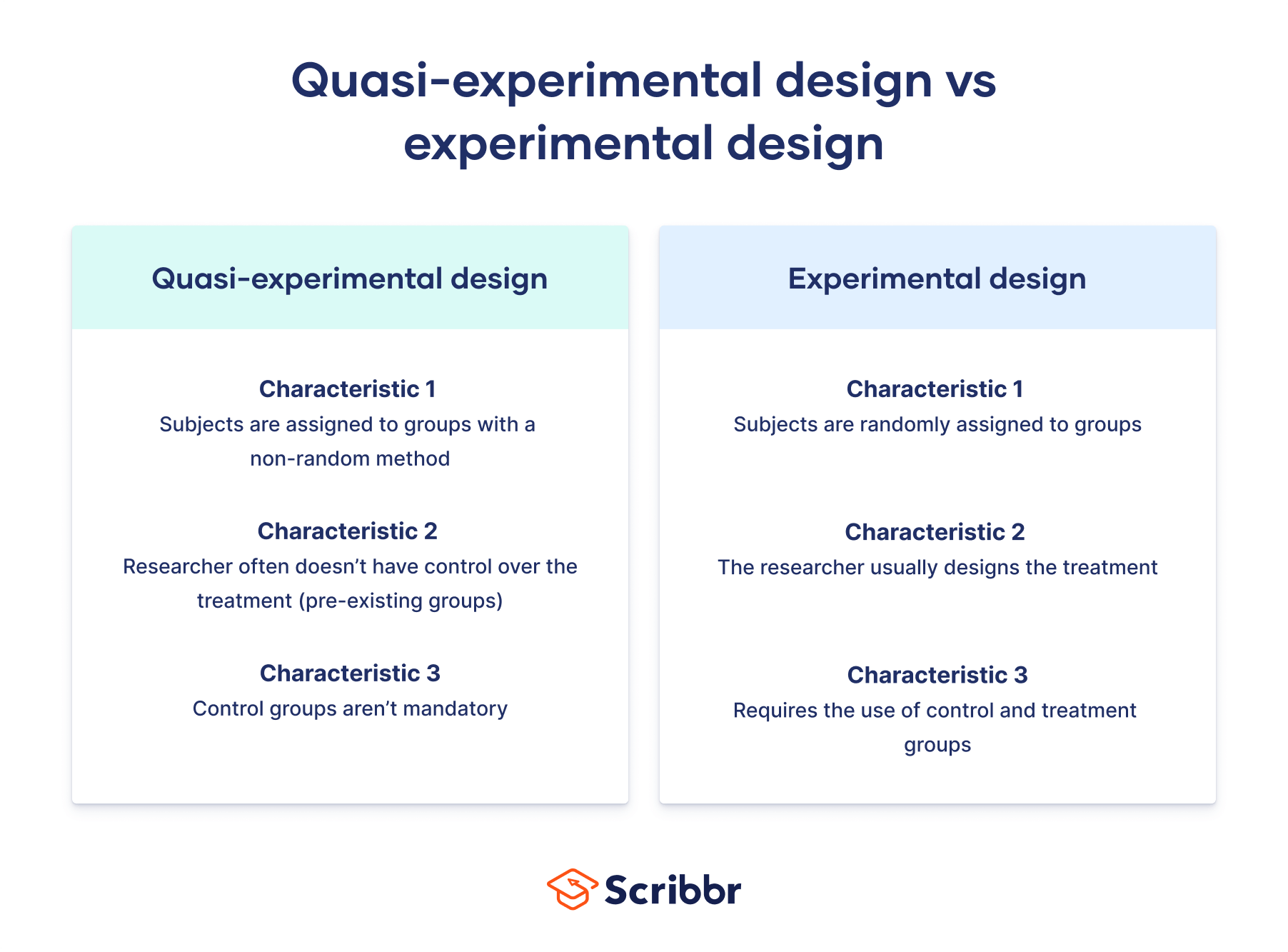Quasi-Experimental Design | Definition, Types & Examples
Like a true experiment, a quasi-experimental design aims to establish a cause-and-effect relationship between an independent and dependent variable.
However, unlike a true experiment, a quasi-experiment does not rely on random assignment. Instead, subjects are assigned to groups based on non-random criteria.
Quasi-experimental design is a useful tool in situations where true experiments cannot be used for ethical or practical reasons.
Differences between quasi-experiments and true experiments
There are several common differences between true and quasi-experimental designs.
| True experimental design | Quasi-experimental design | |
|---|---|---|
| Assignment to treatment | The researcher randomly assigns subjects to control and treatment groups. | Some other, non-random method is used to assign subjects to groups. |
| Control over treatment | The researcher usually designs the treatment. | The researcher often does not have control over the treatment, but instead studies pre-existing groups that received different treatments after the fact. |
| Use of control groups | Requires the use of control and treatment groups. | Control groups are not required (although they are commonly used). |
Example of a true experiment vs a quasi-experiment
Every few months, patients fill in a sheet describing their symptoms to see if the new treatment produces significantly better (or worse) effects than the standard one.
However, for ethical reasons, the directors of the mental health clinic may not give you permission to randomly assign their patients to treatments. In this case, you cannot run a true experiment.
Instead, you can use a quasi-experimental design.
You can use these pre-existing groups to study the symptom progression of the patients treated with the new therapy versus those receiving the standard course of treatment.
Although the groups were not randomly assigned, if you properly account for any systematic differences between them, you can be reasonably confident any differences must arise from the treatment and not other confounding variables.
Types of quasi-experimental designs
Many types of quasi-experimental designs exist. Here we explain three of the most common types: nonequivalent groups design, regression discontinuity, and natural experiments.
Nonequivalent groups design
In nonequivalent group design, the researcher chooses existing groups that appear similar, but where only one of the groups experiences the treatment.
In a true experiment with random assignment, the control and treatment groups are considered equivalent in every way other than the treatment. But in a quasi-experiment where the groups are not random, they may differ in other ways – they are nonequivalent groups.
When using this kind of design, researchers try to account for any confounding variables by controlling for them in their analysis or by choosing groups that are as similar as possible.
This is the most common type of quasi-experimental design.
By comparing the children who attend the program with those who do not, you can find out whether it has an impact on grades.
Regression discontinuity
Many potential treatments that researchers wish to study are designed around an essentially arbitrary cutoff, where those above the threshold receive the treatment and those below it do not.
Near this threshold, the differences between the two groups are often so minimal as to be nearly nonexistent. Therefore, researchers can use individuals just below the threshold as a control group and those just above as a treatment group.
However, since the exact cutoff score is arbitrary, the students near the threshold – those who just barely pass the exam and those who fail by a very small margin – tend to be very similar, with the small differences in their scores mostly due to random chance. You can therefore conclude that any outcome differences must come from the school they attended.
To test the impact of attending a selective school, you can study the long-term outcomes of these two groups of students (those who barely passed and those who barely failed).
Natural experiments
In both laboratory and field experiments, researchers normally control which group the subjects are assigned to. In a natural experiment, an external event or situation (‘nature’) results in the random or random-like assignment of subjects to the treatment group.
Even though some use random assignments, natural experiments are not considered to be true experiments because they are observational in nature.
Although the researchers have no control over the independent variable, they can exploit this event after the fact to study the effect of the treatment.
However, as they could not afford to cover everyone who they deemed eligible for the program, they instead allocated spots in the program based on a random lottery.
Researchers were able to study the impact of the program by using the enrolled individuals as a randomly assigned treatment group, and the others who were eligible but did not succeed in the lottery as a control group.
When to use quasi-experimental design
Although true experiments have higher internal validity, you might choose to use a quasi-experimental design for ethical or practical reasons.
Ethical
Sometimes it would be unethical to provide or withhold a treatment on a random basis, so a true experiment is not feasible. In this case, a quasi-experiment can allow you to study the same causal relationship without the ethical issues.
The Oregon Health Study is a good example. It would be unethical to randomly provide some people with health insurance but purposely prevent others from receiving it solely for the purposes of research.
However, since the Oregon government faced financial constraints and decided to provide health insurance via lottery, studying this event after the fact is a much more ethical approach to studying the same problem.
Practical
True experimental design may be infeasible to implement or simply too expensive, particularly for researchers without access to large funding streams.
At other times, too much work is involved in recruiting and properly designing an experimental intervention for an adequate number of subjects to justify a true experiment.
In either case, quasi-experimental designs allow you to study the question by taking advantage of data that has previously been paid for or collected by others (often the government).
Advantages and disadvantages
Quasi-experimental designs have various pros and cons compared to other types of studies.
- Higher external validity than most true experiments, because they often involve real-world interventions instead of artificial laboratory settings.
- Higher internal validity than other non-experimental types of research, because they allow you to better control for confounding variables than other types of studies do.
- Lower internal validity than true experiments – without randomisation, it can be difficult to verify that all confounding variables have been accounted for.
- The use of retrospective data that has already been collected for other purposes can be inaccurate, incomplete or difficult to access.
Frequently asked questions about quasi-experimental design
Cite this Scribbr article
If you want to cite this source, you can copy and paste the citation or click the ‘Cite this Scribbr article’ button to automatically add the citation to our free Reference Generator.
Thomas, L. (2024, January 22). Quasi-Experimental Design | Definition, Types & Examples. Scribbr. Retrieved 24 December 2025, from https://www.scribbr.co.uk/research-methods/quasi-experimental/

